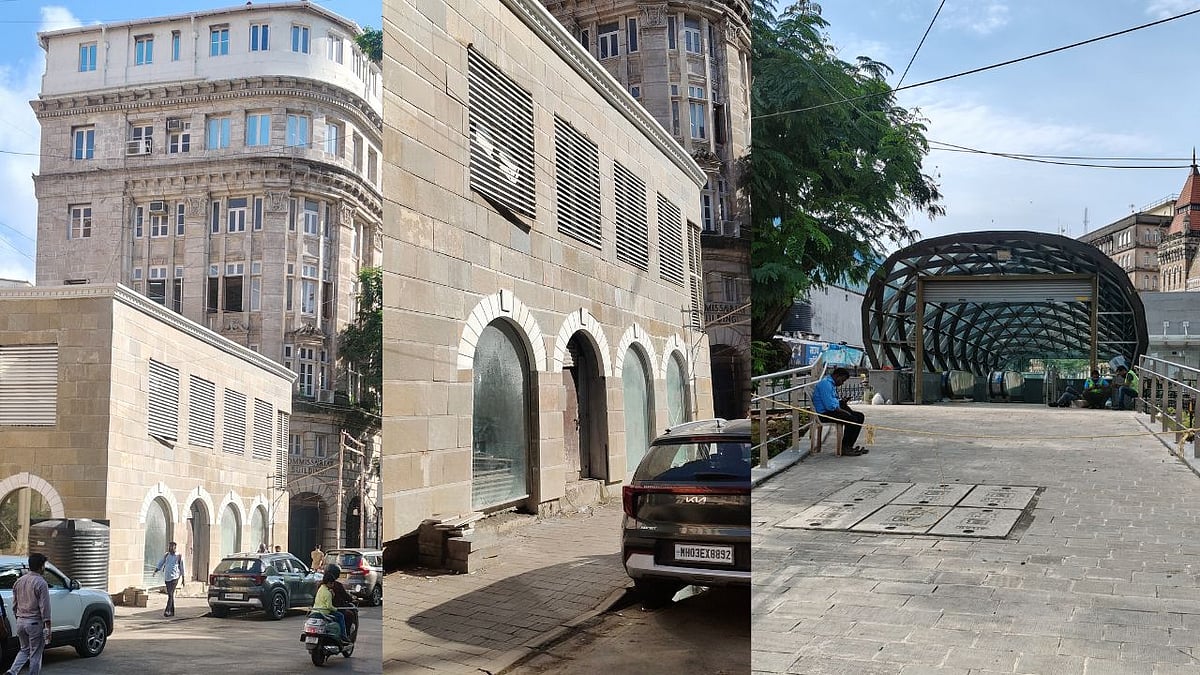Mumbai Metro 3 Blends Heritage And Modernity Along D N Road, Flora Fountain
A particularly striking example is the station entrance near the Commissariat Building, a century-old Renaissance Revival-style structure at the corner of D N Road.

D N Road, Flora Fountain | Manoj Ramakrishnan
Keeping its commitment to preserving the architectural character of South Mumbai’s heritage precinct, the Mumbai Metro Rail Corporation Ltd (MMRCL) has ensured that new Metro 3 (Aqua Line) infrastructure along D N Road, Flora Fountain, and Hutatma Chowk complements the city’s historic streetscape.
The entry and exit points of the underground stations in this district have been designed using stone and glass, avoiding intrusive canopies or bulky surface structures that might disrupt the area’s heritage aesthetics.
Metro Structure Mirrors the Commissariat Building’s Renaissance Design
A particularly striking example is the station entrance near the Commissariat Building, a century-old Renaissance Revival-style structure at the corner of D N Road.
The new two-storey Metro structure replicates the façade of the Commissariat Building, with matching wall tiles and mouldings, echoing its architectural rhythm. This structure will serve as an entry and exit point for the Hutatma Chowk station and will also house a police chowky on the upper floor.
Heritage Restoration Background
Built in 1925, the Commissariat Building was meticulously restored between 2018 and 2021 by a team led by conservation architect Vikas Dilawari, structural engineer Girish Wadhwa, and architect Farhan Lokhandwala.
The building’s covered pedestrian arcade, a hallmark of D N Road, was preserved, while critical structural reinforcements were added during restoration.
Conservationist’s Perspective: “Mixed Feelings”
Dilawari expressed mixed feelings about the Metro structure beside the heritage building. He noted that one school of conservation thought advocates for unobtrusive, glass-based designs in heritage zones.
“This couldn’t be applied here as the new structure is two-storeyed,” he explained. “The Commissariat Building is a beautiful corner structure — that corner is now partially obscured. Still, the new building is not too alarming,” he added.
MMRCL Followed Heritage Guidelines
During Metro construction, the MMRCL maintained that, except for lift shafts and ventilation systems, all station components would be built underground to preserve the precinct’s visual integrity.
Conservation architect Chetan Raikar, former member of the Mumbai Metropolitan Region–Heritage Conservation Society (MMR-HCS), said the MMRCL had adhered to the heritage guidelines set by the committee.
ALSO READ
“We didn’t want the new structures to be drastically different. The designs were finalized after extensive deliberations,” Raikar said.
Two Schools of Thought on Heritage Integration
Raikar further noted, “There are two schools of thought one is to make new additions visibly distinct, as in central London, while the other is to blend new structures with the old through similar materials and design. The latter approach seems to have been taken here.”
Published on: Thursday, October 09, 2025, 04:06 AM ISTRECENT STORIES
-
-
-
-
-